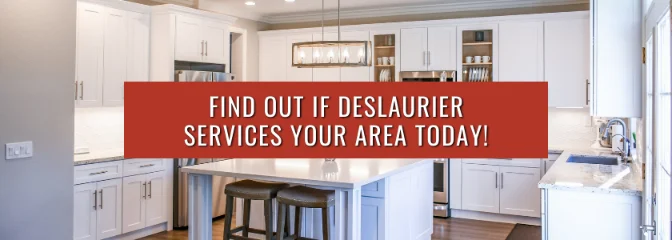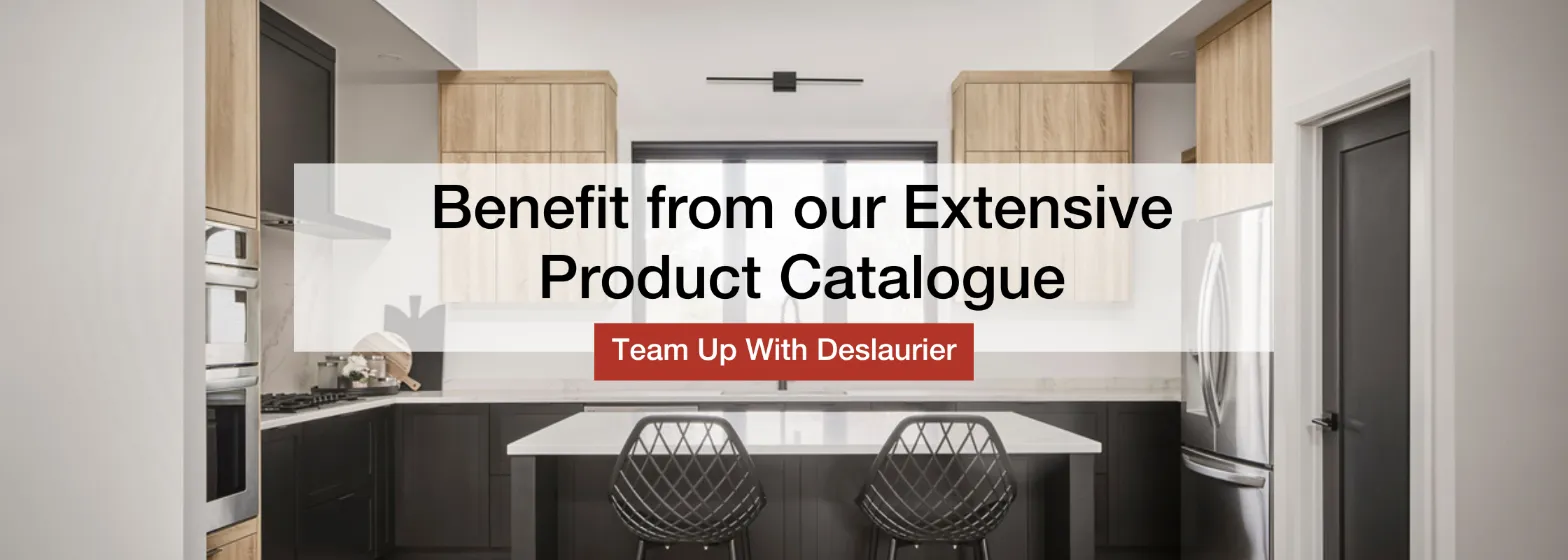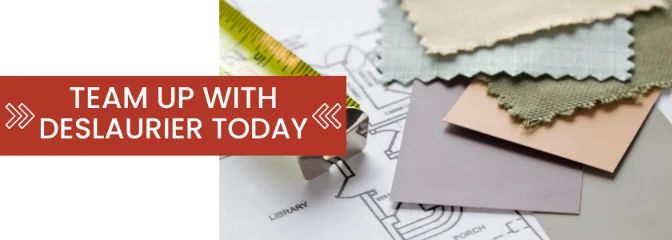14/10/2022 • Blog
Wood Veneer vs. Melamine: Comparing Kitchen Cabinet Materials
Expected Read Time: 10 Minutes
Looking for the perfect cabinet material for your kitchen?
You might have come across wood veneer and melamine cabinets. Both offer beautiful cabinet options with unique qualities.
At Deslaurier, we have over 40 years of experience manufacturing custom cabinets. In that time, we’ve worked with every variety of kitchen cabinet material you can think of. With that, we know how important it is for homeowners to find the perfect cabinet material for their dream kitchen.
This article will compare the qualities of wood veneer and melamine kitchen cabinets to help you better understand which material is ideal for your home.
Let’s get started!
What Are Wood Veneer Kitchen Cabinets?
Wood veneer cabinets provide the look and texture of natural wood at a more cost-effective price point. That’s because wood veneer is actually made of real wood!
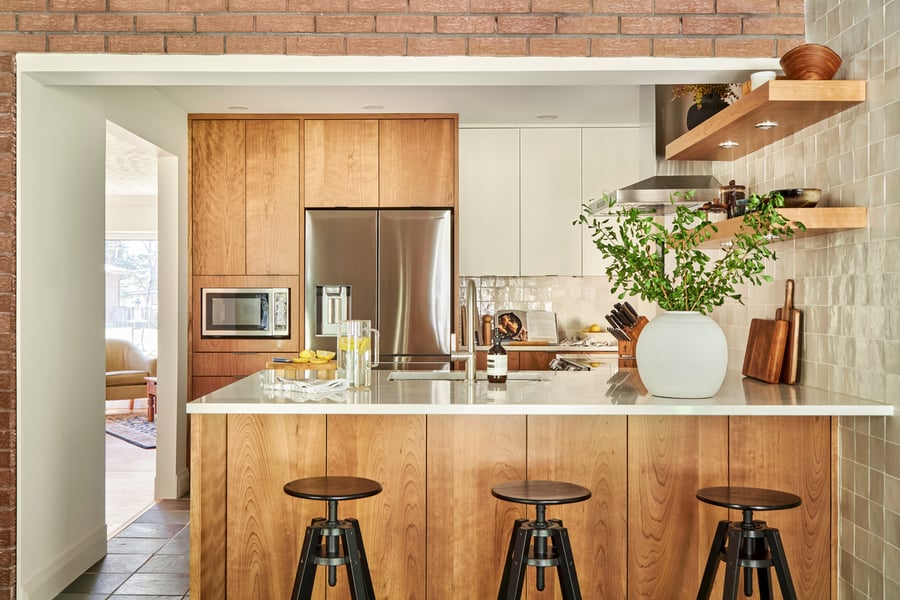
To create wood veneer, a thin sheet of real hardwood adheres to an underlying substrate. While some manufacturers may use plywood for a substrate, wood veneer is most commonly applied to particleboard; the same material that cabinet boxes are made out of.
Along with kitchen cabinets, wood veneer can be used for furniture, tables, and other surfaces where touch and texture are on display. This furniture is typically found in commercial offices, conference rooms, reception desks, and even home offices. Wood veneer is also used to decorate furniture for residential projects as well as commercial projects like hotels or offices.
What Are Melamine Kitchen Cabinets?
Melamine – also known as Thermally Fused Laminate (TFL) – consists of a raw particleboard substrate with resin-infused decorative paper permanently adhered to both sides. Heat and pressure activate the resin to effectively seal the substrate and produce cabinet doors.
Melamine cabinets are popularly used to replicate various wood grains but they also come in solid colours. This material is even capable of surface and texture decor matching. In fact, most manufacturers will carry hundreds of different melamine selections to choose from.
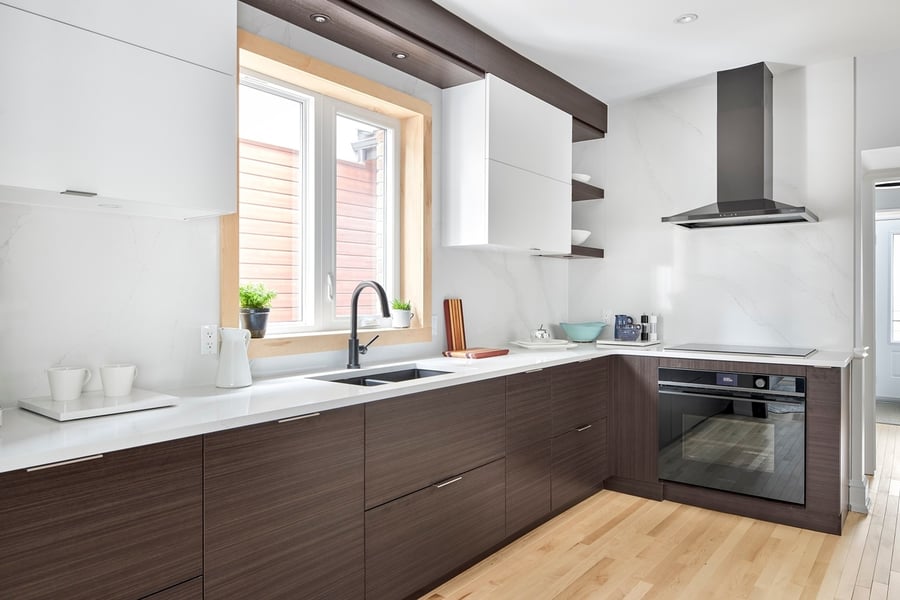
There are two popular kinds of melamine cabinets: textured melamine and European textured melamine.
Textured melamine is the most common style of melamine cabinets. Textured melamine allows for the use of deep, congruent wood grain visuals in a man-made product.
Since the decorative paper is sealed with plastic resins, the surface will have somewhat of a plasticky feel to it, depending on the quality of the product.
European textured melamine (ETM) is considered a higher quality, luxury line of melamine. ETM produces a prestige material with deeper textures and colours, a more realistic-looking wood grain, and even feels more like natural hardwood.
In contrast, with standard textured melamine, ETM does not feel as “plasticky” and is a much more rich and convincing imitation of natural wood.
Wood Veneer vs. Melamine: Appearance
When it comes to cabinet appearance, wood veneer and melamine are two of the most versatile materials you can use. Both materials have hundreds of potential selections and variations to choose from.
Wood Veneer Cabinet Appearance
When it comes to wood veneer cabinets, you’ll actually have a larger variety of wood species to choose from than solid wood.
Veneer is a great way to utilize exotic woods that are harder to source, such as bamboo and mahogany, as well as more expensive woods like walnut and white oak. Not only can wood veneer incorporate these wood species, but also at a fraction of the cost.
However, depending on your manufacturer, some less common wood veneers may only be produced in thin strips that are six inches in width. In this scenario, you might see a subtle outline of the wood grain strips if they do not have a perfectly matching pattern.
That being said, the more popular and affordable woods, like maple or oak, will consistently be produced in much wider sheets of veneer so that the grain looks more consistent.
Since the surface of wood veneer doors is made from real materials, wood veneer can be finished with stains and paints, just like solid wood.
Wood veneer doors can actually be colour and stain matched. This is because the real wood allows for the stain to adhere over the grain in the same fashion as a solid wood door.
Melamine Cabinet Appearance
Since melamine cabinets use printed images, they can accurately replicate a vast amount of wood species’ grains or alternative surfaces. In fact, melamine will produce a more uniform, consistent wood grain than a natural wood species. This is because hardwoods are natural materials; therefore no two cabinets will have the exact same grain patterns. Melamine will.
Solid colour melamine is not nearly as popular as the wood grain variety but they do offer a nice alternative to traditional melamine wood grain aesthetics. Solid melamine comes predominantly in a variety of blacks, greys, beiges, and whites, with some manufacturers possibly offering a handful of “colourful” options as well.
It should be mentioned that picking a finish for your melamine cabinets might be slightly restrictive. While there are plenty of solid colours, or deep, textured wood grains available, you’ll be limited to selecting only what is offered by the manufacturer.
That means, if you don’t like a certain colour or wood stain, there is no customizing it with a different shade or hue. What’s in your supplier’s catalogue is what you’re stuck with.
In that sense, if you want to personalize your cabinet’s appearance, wood veneer offers more flexibility of the two. Likewise, if you’re after a seamlessly symmetrical wood grain pattern, textured melamine is unrivaled.
Wood Veneer vs. Melamine: Design Style
The main aesthetic limitation of wood veneer cabinets is that the sheets cannot be applied to any 3-dimensionally designed cabinet door styles. Although that may be a concern for raised panel doors (you’ll have to go with solid wood), there is a way to incorporate wood veneer into 5-piece doors.
A 5-piece door consists of one large centre panel, with 2 rails and 2 stiles on top, creating a border. The flat surface of wood veneer is perfect to implement as the centre panel of a 5-piece door and reduces the overall cost of the cabinet door (more on that later).
While wood veneer crown and trim can only be flat, the benefit of wood veneer is that it can be matched with its solid wood species counterparts. This allows for solid wood decorative mouldings, crown, trim and other ornamentation to be paired with wood veneer doors.
Similarly, melamine will almost always come in a slab (flat) door style. Some manufacturers may offer 5-piece doors, but they are relatively few and far between, and the quality of the product is extremely lacking compared to MDF or natural wood 5-piece doors.
Since melamine is restricted to slab doors, everything else will be flat as well. Any decorative crown or trim moulding will be flat, with no opportunity to modify or customize the design. Unlike wood veneer, you won’t be able to pair melamine cabinets with solid wood decorative trim and mouldings.
Simply put, if you’re going with a melamine cabinet, your kitchen will have a flat panel aesthetic.
Wood Veneer vs. Melamine Cabinets: Durability
Wood Veneer Durability
Wood veneer’s main durability concern is its susceptibility to water damage.
That goes back to the particleboard substrate – if water gets past the veneer it can spread within the particleboard, causing the door to expand. Excessive moisture or water damage can also cause the veneer sheet to loosen or “bubble” from its base.
Compared to solid wood, wood veneer is more vulnerable to scuffs and scratches. Don’t worry, they’re easy to treat! Mild scuffs can be covered with quality furniture polish while deeper scratches may require a wax filler to fix any unsightly damage.
Speaking of damage, corners and lower edges of wood veneer cabinets are prone to chipping. If a door does become chipped along a corner or edge, the veneer sheet may begin to peel and show the underneath substrate. Although it would take a significant amount of chipping for this to occur, it does underline the importance of spotting any damage before it can worsen.
Melamine Durability
Unlike other fused cabinet door products, such as thermofoil, melamine will not peel away or delaminate from its base. This is thanks to the resin-filled paper being permanently fused to the particleboard substrate.
Although textured melamine and European textured melamine are quite similar to one another, ETM is a thicker product and holds up better to everyday bumps and dings.
While regular standard textured melamine is still a durable product, issues can arise. The corners, for example, can be prone to chipping.
Chips will result in the substrate becoming exposed. Depending on the size of the chip, this will leave the door looking flawed and the exposed particle board vulnerable to water damage that can spread throughout the material.
Speaking of water damage, thanks to the plastic coating, both types of melamine hold up well to liquid. If the doors get wet, be sure to properly dry them and there should be no issues.
That being said, the particleboard substrate is extremely vulnerable to water damage. If the particleboard becomes exposed, from chips, scratches, or other damage, any liquid that finds its way within the substrate will spread like wildfire, even at the molecular level.
So as long as the finish on the doors is not compromised, water should not be an issue.
Wood Veneer vs. Melamine Cabinets: Cost
Cost of Wood Veneer Cabinets
As we’ve mentioned, using wood veneer is a more affordable way to include natural wood cabinets in your kitchen compared to solid wood. Let’s show you what we mean with a cost comparison.
For this exercise, we’ll use Deslaurier’s pricing for two oak cabinets: one upper and one base, both with a standard stain. The cost of those two cabinets in solid oak would be roughly $1150. Exchanging the solid oak centre panel with an oak veneer panel would lower the total cost to $920.
Simply swapping the centre panel with a wood veneer, with the stiles and rails remaining solid wood, can save roughly $50 per cabinet door! Depending on the size of your kitchen, that basic change can wind up saving you thousands of dollars on your kitchen cabinetry expenses.
Cost of Melamine Cabinets
Similarly to wood veneer, standard melamine is a significantly more cost-effective way to replicate other premium cabinet selections like painted MDF or natural wood cabinets.
For example, if a custom kitchen outfitted with maple cabinets were to cost $25,000, the same kitchen design in a faux maple grain melamine could come in roughly $7,000 to $12,000 cheaper.
That’s a stark contrast in pricing, and why melamine is worth consideration if your main priority is the visual aesthetic of your cabinets. Melamine’s cost-effective pricing is one of the reasons why it is such a popular and budget-conscious choice for kitchen cabinets.
With regards to ETM, pricing is a lot steeper than standard melamine. European textured melamine is a premium, high-end product, and is priced accordingly. It is not uncommon for the price of ETM to rival that of painted MDF or a natural wood like cherry or alder.
Wood Veneer vs. Melamine Cabinets: What’s Right For You?
When choosing between wood veneer and melamine, it ultimately comes down to your personal aesthetic preferences.
Since both options offer beautiful cabinets in their own unique style, it's up to you to decide which avenue suits your dream kitchen best.
If you’ve always wanted natural wood cabinets in your kitchen, wood veneer can give you that at a discounted price from solid wood. Veneer also provides the ability for 5-piece cabinet door styles as well as decorative trim and mouldings.
If you like modern slab doors with an emphasis on the appearance of your cabinets, melamine is the best option. Their engineered cabinets offer pristine appearances with perfect replicas of wood grains, paints, and other pattern options.
Ultimately, it’s always important to consider your budget, your design preferences, and your lifestyle to choose the best cabinet material for your dream kitchen.
Design with Deslaurier Custom Cabinets
At Deslaurier, we believe there’s a cabinet style in our collection for every design taste.
Want to inspect the differences between wood veneer and textured melamine cabinets for yourself? Book a consultation for a one-on-one experience with a Deslaurier kitchen expert at our Jupiter, Florida showroom or schedule a virtual meeting!
If you have your eye on custom cabinetry, Deslaurier Custom Cabinets has everything you need. With over 40 years of experience to our name, we provide our clients with a fully customized design process with our talented team of designers.
Interested in becoming an authorized Deslaurier dealer? Visit our Become a Dealer page to learn more! Live outside the area? Find a Dealer to connect with a Deslaurier dealer near you!
